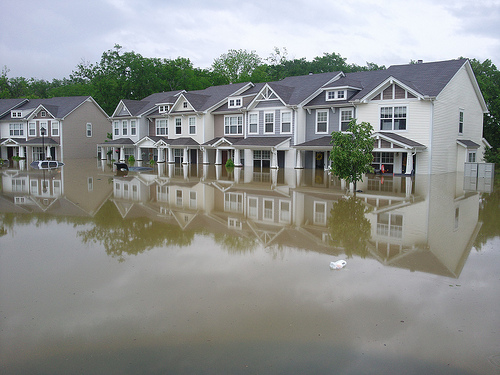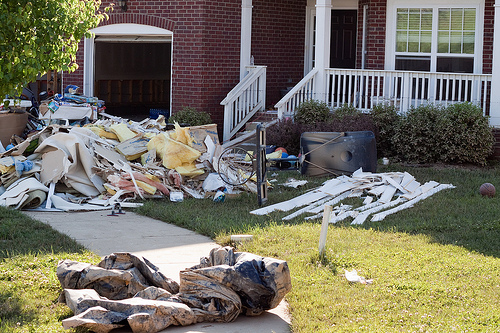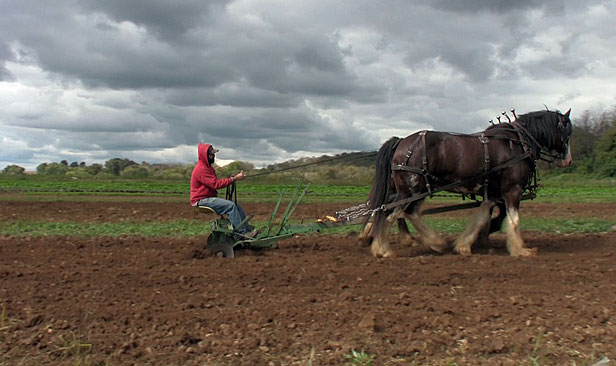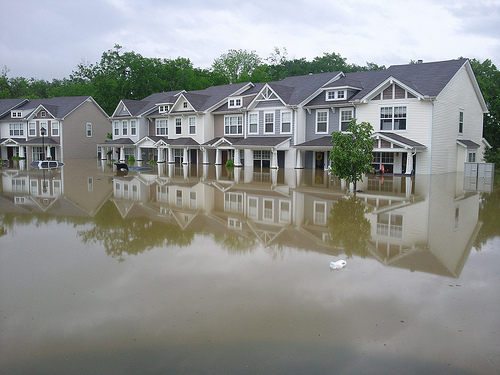 Homes in Nashville.Photo courtesy Eric Hamiter via FlickrNASHVILLE, Tenn. — Four days after rainstorms pummeled my hometown, problems mount. Major portions of the city are still submerged beneath floodwaters. Thousands are displaced from their homes, the contents of their lives soaked, mud-caked, and molding. Thousands more have no electricity or plumbing. The city faces severe drinking water shortages, with several water treatment facilities paralyzed. On Tuesday, President Barack Obama declared Nashville a federal disaster area.
Homes in Nashville.Photo courtesy Eric Hamiter via FlickrNASHVILLE, Tenn. — Four days after rainstorms pummeled my hometown, problems mount. Major portions of the city are still submerged beneath floodwaters. Thousands are displaced from their homes, the contents of their lives soaked, mud-caked, and molding. Thousands more have no electricity or plumbing. The city faces severe drinking water shortages, with several water treatment facilities paralyzed. On Tuesday, President Barack Obama declared Nashville a federal disaster area.
On stoops and porches around the city, Nashvillians are sharing stories of shock, anguish, and wonder. They are recounting images of the homes and churches that were torn from their foundations and carried away when the river surged; of the waterlogged cars and buses that quietly floated down flooded highways like sheep in a migrating herd; of the asphalt roads, sidewalks, and driveways that peeled off the ground like fragile skins.
The stoop chatter celebrates the lives of hundreds of survivors who clung to tree trunks and car roofs or were rescued by boats from rooftops and second-story windows. And it mourns the deaths of 21 residents who succumbed to the raging floodwaters.
My family got off lucky: The 4 feet of water that flooded our basement only claimed storage boxes, a boiler, and a furnace — never creeping up to the first floor to damage our living space. Some of our friends weren’t so fortunate. The muddy waters snaked into their ductwork and entered their kitchens, bedrooms, and dens, warping their floors and leaving a foul residue on furniture, clothes, bed linens, and baby cribs.
 Photo courtesy ahoy matey via FlickrI joined a group of cheerful volunteers — there are thousands of them citywide — buzzing around flood-stricken homes, scrubbing walls, ripping out sodden ductwork, boxing up whatever belongings can be salvaged, and transplanting families to temporary dwellings. Conversations often veer toward recent natural disasters that have come to seem absurdly frequent: the earthquakes in Haiti, China and Chile that took so many lives; hurricanes Katrina and Gustav; and the northeastern blizzard in January.
Photo courtesy ahoy matey via FlickrI joined a group of cheerful volunteers — there are thousands of them citywide — buzzing around flood-stricken homes, scrubbing walls, ripping out sodden ductwork, boxing up whatever belongings can be salvaged, and transplanting families to temporary dwellings. Conversations often veer toward recent natural disasters that have come to seem absurdly frequent: the earthquakes in Haiti, China and Chile that took so many lives; hurricanes Katrina and Gustav; and the northeastern blizzard in January.
“It feels like the earth is mad at us,” said one volunteer.
But few people I’ve spoken with mention global warming. They’re focused, understandably, on the immediate tasks at hand — managing the day-to-day challenges of cleaning up wreckage, filing insurance claims and relocating. But in the coming months, as Nashvillians reflect on this shock, we may conclude that we’ve gotten a firsthand glimpse of the symptoms of a warming planet.
I don’t believe that this particular storm was caused by climate change. After all, major storms are expected this time of year in the Southeastern U.S. But the unprecedented intensity of this storm — which produced the largest volume of rainfall from a single storm on record in the state of Tennessee — is closely tied to warming climate trends.
Dr. Kevin Trenberth, head of the Climate Analysis Division at the National Center on Atmospheric Research, explained the phenomenon this way: A warmer climate means warmer oceans and moister air, which in turn intensifies storms. “Global warming contributes to higher air and sea temperatures,” he said, “as a result you get increased moisture in the atmosphere and more intense rainfall events.” He pointed to governmental data showing a 20 percent increase in heavy precipitation in the past 50 years throughout the Southeastern region of America.
Until now I have understood the power of nature — specifically, the power of water — only in theory. It cuts chasms into rocks as vast as the Grand Canyon. It turns boulders into fine sand. But I never quite grasped its ability to swallow homes and rupture human lives. Even after Hurricane Katrina, which I observed from afar, I didn’t actually feel — or understand — the human impacts of a natural disaster. Maybe you never do until you can smell and touch those impacts; until you try to help pick up the pieces of lives forever changed by them.
Perhaps only then — only when a critical mass of Americans have seen and felt the human impacts of a changing climate — will we devise a bold national strategy to address the root causes of global warming and prevent more extreme weather events in the future.
In the meantime, Nashville has an opportunity to lead: As we gird for the next big flood by installing sump pumps and drainage systems, we can also try to prevent it — by reducing our climate impact — by wrapping our boilers and sealing the cracks in our walls that cause our homes to leak heat in the winter and cool air in the summer; by installing affordable energy-efficient lights and appliances.
Yesterday, my husband and I replaced the 18-year-old furnace in our heating system that broke in the flood. We invested in a superefficient model that gets a $1,500 federal tax credit and negotiated a reasonable two-year financing plan. It will save us money in the long run, significantly cutting our heating bills while shrinking our carbon footprint.
The city of Nashville is not just a federal disaster area, it is a federal opportunity. As we pump floodwaters from our submerged streets, we must also devise sweeping strategies to reduce our climate impact and create green jobs. Nashville can do more than recover from this tragedy — we can become a stronghold of new, green innovation.
That will do more than prevent further disaster, it will create jobs, strengthen our economy — as a city, state, and country — and build our national morale.
This piece was originally published by AOLNews.



